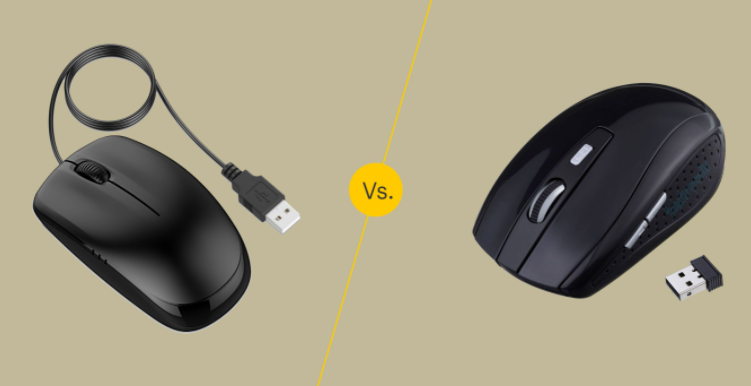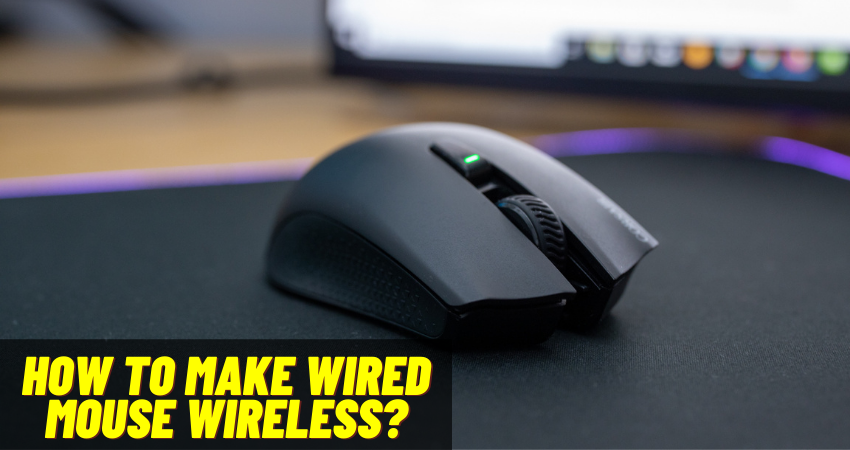I am a professional laptop and computer troubleshooter, tech editor who loves to talk about technology and software. My passion is electronics devices. Follow me...Read more
A computer mouse is the primary mode of navigation. Without it performing tasks on a pc will be tiresome. A personal favorite of so many users is the wired computer mouse, but the wire tends to be annoying during use. If you fall under the category above, you might have wondered how to make wired mouse wireless.
The good news is it is possible. You can transform your wired mouse into a wireless one with a modest amount of modifications. Read this article carefully to know how this is done.
Which Is Better: Wireless or Wired Mouse?
Nowadays, trackpads found on laptops are advanced and more responsive. Still, some users prefer using an external mouse. Users with desktops don’t even have trackpads; an external mouse is necessary.
Choosing the type of mouse to buy is a decision any user will go through when shopping for an external mouse. Each has its advantage; it all comes down to the task you intend to use them for.
Difference Between a Wireless and Wired Mouse
Data Transfer
A wired mouse will always be faster than a wireless mouse because information moves faster when it passes a physical cord. Over the years, improvements have been made to the performance of wireless mice; you can barely feel any latency during normal pc tasks.
It becomes an issue with high-performance games. Often you will notice a delay in the response time. This is why gamers prefer using wired mice, as they provide the best response time.
Comfort and Ease of Use
The problem wireless mouse was created to solve is the issue of a cord dangling while navigating your computer. Using a wired mouse can be annoying because the cord impedes movement; let’s not forget your range of motion is also affected by the cord’s length.
A wireless mouse is just more comfortable to use and carry; some even have a slot where you can store the receiver. Instead of carrying a mouse with a cord that tends to tangle, you are left with a lighter portable one.
Battery
Wired mice get their power from the computer’s motherboard, so you don’t need to charge it or bother about battery change. This is totally different with wireless mice.
A wireless mouse relies on removable or rechargeable batteries (depending on the model) for power. The batteries need to be replaced when the energy level is depleted. If you don’t wish to replace your batteries, you can get a mouse with a rechargeable battery.
Cost
As expected, the mouse which offers more comfort and portability is costlier. Wireless mice are noticeably more expensive than the wired version; you need to choose based on the features you prioritize.
If you’re a hardcore gamer, there is no need to pay extra to get a wireless mouse because wired performs better. Likewise, if comfort is an issue to you, then a wireless mouse is your best bet.
Compatibility
If you use a wired mouse, all you need to do is plug and play; this is done via the USB port.
Some wireless mouse models like a Bluetooth mouse don’t need anything to be plugged into your system; you pair to them via your PC’s Bluetooth. Other models use radiofrequency and use a receiver that would be plugged into the computer via a USB port.
Is Converting My Wired Mouse to Wireless a Good Idea
If you intend to use the converted mouse for daily tasks, it’s not practical. The end product will likely be bulky, and there is a high probability of feedback lag with your computer. It is easier to buy a mouse, with the tons of options available now, there is surely a device for you.
How to Make Wired Mouse Wireless
The cord of a wireless mouse can hinder movement. For users who find this bothersome, how do we work around this? By modifying certain components of our mouse, it is possible to make wired mouse wireless.

Before we proceed, it is worth noting that simply buying a wireless mouse is stress-free and practical. Unless there is something special about the wired mouse in question, we recommend you simply purchase a wireless mouse.
Certain components need to be added to a wired mouse before it can function as a wireless one. We will look at each function and explain how to integrate it into your wired mouse, thus converting it to a wireless mouse;
Alternative Power Supply
Our first step would be providing power to our mouse. You see, a wired mouse gets its power from a computer’s motherboard. If we are to convert it, we need to provide an alternative power supply. An ideal option will be a small-sized battery like the ones found in television remotes.
You would need to create an external housing unit for this battery. The internal layout of a wired mouse is quite different from an external one, and finding space inside it for the batteries might prove difficult.
Once you have successfully made a housing unit for your batteries, figure out how to connect it to the power supply nodes. Most likely, your build will be bulky; we did mention this wasn’t practical.
Data Transfer
A wired mouse uses its cord to send and receive data. By cutting it off, you have closed that channel. An alternative needs to be provided. A typical wireless mouse utilizes radio frequency transmitters or Bluetooth to do this task. To make our wired mouse wireless, we need to find an alternative mode of data transfer.
The solution to our data transfer problem will be finding a way to attach a transmitter to our mouse. You see, a wireless mouse has an inbuilt transmitter that connects to the receiver attached to your computer’s USB port. Some transmitters use radio frequency while others use Bluetooth; for a task like this, a radio frequency transmitter would reduce the data latency instead of Bluetooth.
A Bluetooth transmitter might still work; it’s not set in stone. Depending on the mouse type, there might not be room inside for the transmitter. If you manage to fit the transmitter in the mouse, find a way to connect it to the data output portion of the mouse. Plug your receiver into your laptop, and it should work properly.
Verdict
Converting your wired mouse to wireless requires some knowledge of electrical components and principles. Data latency is also a problem, so you might need to reprogram the transmitters to fix this, so a little coding knowledge is also necessary. You can see how stressful converting a wired mouse to wireless will be.
If your mind is set on performing this task, you can always approach an electronic technician in your vicinity to help out.
This Youtube video also provides an additional guide on how to get this conversion done.
How to Use Your Computer Without a Mouse
There are certain scenarios where your trackpad (if you use a laptop) might be faulty, and you don’t have access to an external mouse. How do you use your computer without a mouse?

Direction keys
By using the four direction/arrow keys on your computer, you can navigate the open window. If you’re in a program like a file explorer or your window home screen, you can just type the first letter of the file or program you need, and it will jump to it.
ALT + TAB
Using the alt + tab button will cycle through all open programs.
WIN + D
Using the Win + D key will minimize all open programs.
Make Your Keyboard a Mouse
On the other hand, for situations of mouse side buttons not working, we can also assign the four axes of a mouse movement to our keyboard;
- Open the start menu by pressing the windows key (key with windows logo on it)
- Input “ease of access” in the search menu and press enter
- When the option comes up, you can use the “up and down key” to navigate to it and press enter.
- In the ease of access menu, navigate with the “up and down” key to “make the keyboard easier to use”. Press the “enter” key to proceed
- Use the “up and down” keys to navigate the “set up mouse keys” option. Press “enter” to activate this option.
- Using the navigation process in the previous steps, activate the “turn on mouse keys” option.
- To adjust the pointer speed, move the “up and down” key till you’re in the “pointer speed” section. You can now use the “left and right” key to adjust the pointer speed.
- Using the navigation process above, you can also adjust the
Top speed- Sets the fastest speed your mouse pointer can attain.
Acceleration- This regulates how quickly your pointer attains its top speed. Use the “left and right” keys to adjust these two options.
- Once you’re done setting these parameters, navigate to the bottom of your screen and select “ok”. This enables the mouse keys feature.
- The number pad is what will be used for navigation. Using the 4, 8, 6, and 2 keys, you can move the mouse left, up, right, and down.
- For movements of 45º, make use of the 1,7, 9, and 3 keys.
- If the mouse pointer refuses to respond even after setting the ease of access parameters properly, press the “Num, (or FN + Num) if the former doesn’t work.
Conclusion
Now you know how to make wired mouse wireless. A little bit of engineering is all it takes. An alternative power source and a new way to transfer data are the two main problems that need to be addressed when converting a wired mouse to a wireless version. If completed, it is important to note; the end product will be bulky and impractical for daily use, not to mention there would be a great deal of latency.
But with the different high-end models available on the market now, simply buying a wireless mouse should be sufficient.
I am a professional laptop and computer troubleshooter, tech editor who loves to talk about technology and software. My passion is electronics devices. Follow me on social media.
More Posts